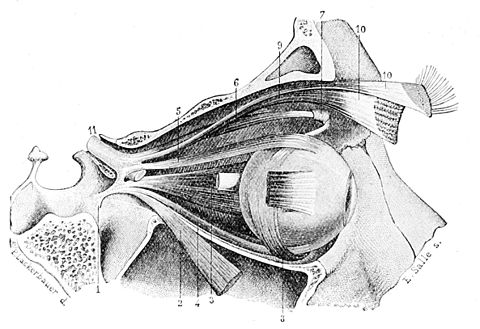position. The image is formed in the eye in the way in which an image is produced and thrown on a screen by a magic lantern.
When a ray of light passes obliquely from the air through glass, water or other transparent media, it is bent, or refracted, and the angle at which it is bent is called the index of refraction. In passing to the retina, the rays of light pass through the cornea, a watery liquid (the aqueous humor) surrounding the lens, the crystalline lens, and a gelatinous liquid (the vitreous humor) filling the posterior two thirds of the globe, all of which have the same index of refraction. This provides that a ray of light, having once passed through the cornea, is not refracted in passing through the other transparent media, except by the curvatures of the crystalline, which is a double-convex lens situated just behind the pupil. The rays of light are not reflected within the eye itself, for the opaque parts of the globe are lined with a black membrane (the choroid), as the tube of a microscope is blackened for a similar purpose. Practically, the bending of the rays of light is produced by the curved surface of the cornea and

Fig. 1.—This figure gives a general view of the eyeball, the outer wall of the orbit being removed: 1, tendon of origin of three of the muscles of the eyeball; 2, the external straight muscle divided and turned down so as to expose the lower straight muscle; 3, 4, 5, 6,7, 8, muscles moving the eyeball; 9, 10, 10, muscle which raises the upper eyelid; 11, optic nerve. (After Sappey.)
the two curved surfaces of the double-convex crystalline lens. These three curved surfaces bring the rays from an object to a focus exactly at the retina in a normal eye. When, however, the eye is too long, the focus is in front of the retina unless, in near vision, the object be brought very near the eye, and the person is near-sighted. For ordinary vision, such persons must wear prop-

